What is a Qualified Charitable Contribution?
Qualified charitable distributions, also known as QCDs, are distributions made directly to a charity that can be used in place of required minimum distributions (RMD) to eliminate tax on the amount donated. QCDs can be distributed after an individual turns 70½, even if they haven’t reached the age when RMDs begin. The current RMD age was changed after the passing of SECURE ACT 2.0 in 2022- and is 73, or 75 for anyone born in 1960 or later. However, traditional IRAs aren’t the only kind of account that meets RMD requirements. Other accounts with RMD requirements include SEP IRAs, SIMPLE IRAs, 401(k)s, and 403(b)s. So, can QCDs be made from these accounts to satisfy RMDs? Let’s take a closer look.
SEP IRAs
Let’s start with the SEP IRA, which stands for Simplified Employee Pension individual retirement account. A SEP IRA is a type of retirement plan established by an employer with fewer than 25 employees, including self-employed individuals with no employees. Sole proprietors or small business owners adopt SEP IRAs to provide retirement benefits for themselves and, if applicable, their employees. SEP IRAs have the same RMD requirement as an IRA. The balance of a taxpayer’s SEP IRA can be aggregated with all the taxpayer’s other IRA accounts to determine the RMD. The RMD can be taken from any IRA account. A taxpayer could make a QCD from an IRA to satisfy the RMD for their SEP IRA.
The IRS prohibits QCDs from “ongoing” SEP IRAs. An “ongoing” SEP IRA is one that receives a contribution for the year in which the QCD is being considered. Taxpayers can continue contributing to SEP IRAs after the age of 70½, provided they have earned income. Therefore, taxpayers with SEP IRAs who no longer receive contributions can make QCDs directly from the SEP. A taxpayer making active SEP contributions must move funds from the SEP to a traditional IRA before making a QCD.
SIMPLE IRAs
The SIMPLE IRA, or savings incentive match plan for employees, is another type of IRA. A SIMPLE IRA is an employer-provided retirement plan available to employers with no more than 100 employees. The SIMPLE IRA works like a 401(k), allowing employees to make salary deferrals to contribute to the plan. SIMPLE IRAs have the same RMD requirement as regular IRAs. A taxpayer’s SIMPLE IRA balance can be aggregated with the taxpayer’s other IRA accounts to determine the RMD. The RMD can be taken from any IRA account. A taxpayer could make a QCD from a traditional IRA account that would be large enough to satisfy the RMD from their SIMPLE IRA.
Like the SEP IRA, a QCD cannot be done from a SIMPLE IRA that received a contribution that year. The workaround is the same as with a SEP IRA—except that contributions to SIMPLE IRAs must be held for two years before they can be rolled into a traditional IRA. Once the two-year holding period has been satisfied, a taxpayer can transfer funds directly to their traditional IRA to make a QCD.
Other Retirement Plans
The tax code does not allow QCDs from other employer-sponsored plans—such as the popular 401(k) or 403(b) plans. A primary difference between IRAs and employer-sponsored retirement plans is that plan participants who are still working get a pass on making RMDs (unless they own more than 5% of the company). This is, appropriately, called the “still working” exception. Even after an individual reaches their RMD age, the first RMD is not due until April 1 of the year after they stop working at the company.
The balance in a taxpayer’s 401(k) or 403(b) account cannot be aggregated with other IRA accounts to calculate the total RMD. Each employer-sponsored plan has its own RMD to satisfy. For example, John’s RMD for his IRA is $20,000, and his 401(k) is $25,000. John cannot take $45,000 from his IRA to satisfy the total RMD. He must take $25,000 from his 401(k) and $20,000 from his IRA separately.
A retired taxpayer could roll over some or all of their 401(k) to an IRA and then make a QCD directly from the rollover IRA. Some employer plans allow working taxpayers to make in-service withdrawals. The working taxpayer could take an in-service withdrawal to a rollover IRA and then process a QCD to a charity.
Note, however, that the rollover strategy will not satisfy the current RMD from a 401(k). In the example above, John already has a $25,000 RMD requirement that an IRA cannot satisfy. He can’t roll over the $25,000 and then do a QCD to meet his RMD. The 401(k) must always meet its own RMD requirement. John must take his $25,000 as a taxable RMD from his 401(k) for the current year. He could then roll over his 401(k) balance to an IRA, avoiding this situation next year.
Effective tax planning is a long-term, complex strategy that should be started before reaching age 70½. Talk to your tax and/or financial adviser about your charitable goals to determine how to minimize your future tax liability.
Originally Posted: August 22, 2019



